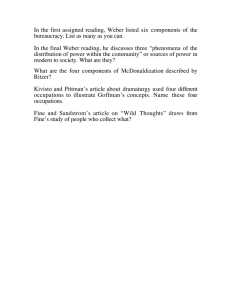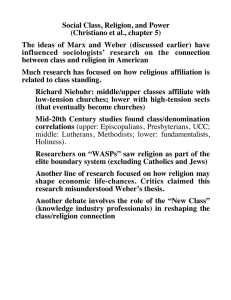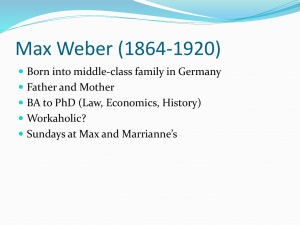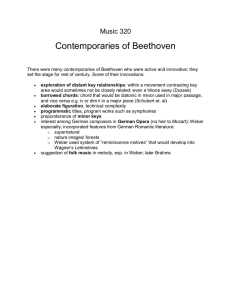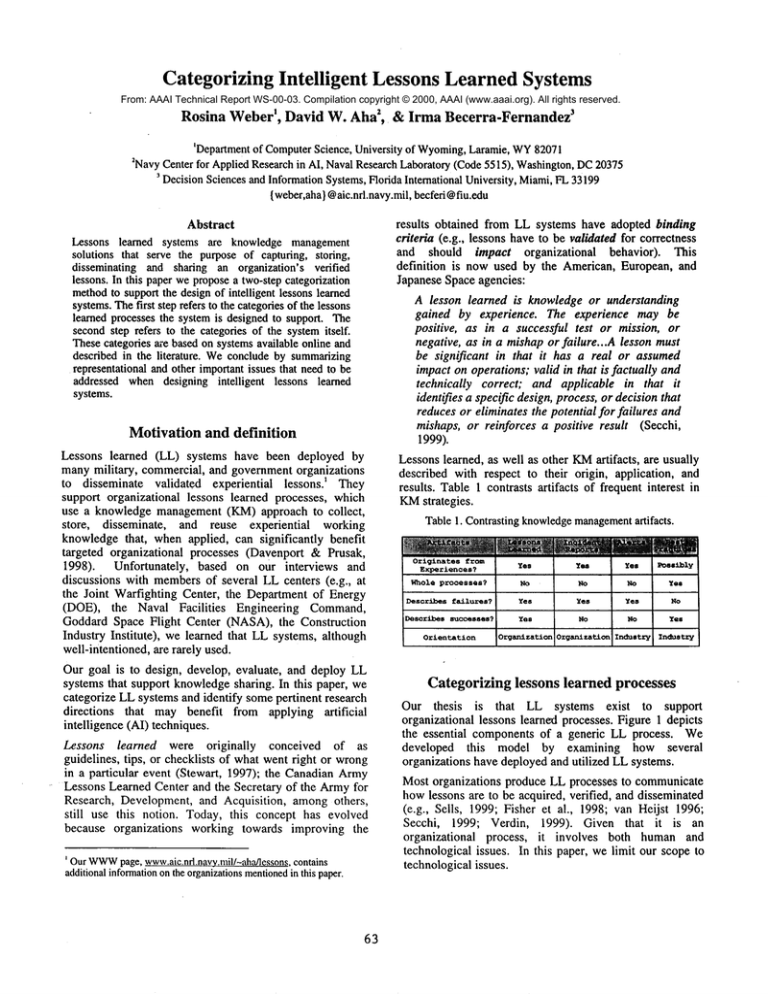
Categorizing Intelligent
Lessons Learned Systems
From: AAAI Technical Report WS-00-03. Compilation copyright © 2000, AAAI (www.aaai.org). All rights reserved.
Rosina
WeberI,
David W. Aha2, 3& Irma Becerra-Fernandez
’Departmentof ComputerScience, University of Wyoming,
Laramie,WY82071
~NavyCenter for AppliedResearchin AI, NavalResearchLaboratory(Code5515), Washington,DC20375
3 DecisionSciencesand InformationSystems,Florida International University, Miami,FL33199
{ weber,aha
} @aic.nrl.navy.mil,beefed@fiu.edu
results obtained from LL systems have adopted binding
criteria (e.g., lessons have to be validated for correctness
and should impact organizational
behavior). This
definition is now used by the American, European, and
Japanese Space agencies:
Abstract
Lessons learned systems are knowledge management
solutions that serve the purpose of capturing, storing,
disseminating and sharing an organization’s verified
lessons. In this paperwe proposea two-stepcategorization
methodto supportthe designof intelligent lessons learned
systems.Thefirst step refers to the categoriesof the lessons
learned processes the systemis designed to support. The
secondstep refers to the categories of the systemitself.
Thesecategories &-e basedon systemsavailable online and
described in the literature. Weconcludeby summarizing
representationaland other importantissues that needto be
addressed when designing intelligent lessons learned
systems.
Motivation
A lesson learned is knowledge or understanding
gained by experience. The experience may be
positive, as in a successful test or mission, or
negative, as in a mishapor failure...A lesson must
be significant in that it has a real or assumed
impact on operations; valid in that is factually and
technically correct; and applicable in that it
identifies a specific design, process, or decision that
reduces or eliminates the potential for failures and
mishaps, or reinforces a positive result (Secchi,
1999).
and definition
Lessons learned (LL) systems have been deployed
manymilitary, commercial, and governmentorganizations
to disseminate validated experiential lessons.’ They
support organizational lessons learned processes, which
use a knowledge management(KM) approach to collect,
store, disseminate, and reuse experiential
working
knowledgethat, when applied, can significantly benefit
targeted organizational processes (Davenport & Prusak,
1998). Unfortunately,
based on our interviews and
discussions with membersof several LL centers (e.g., at
the Joint Warfighting Center, the Department of Energy
(DOE), the Naval Facilities
Engineering Command,
Goddard Space Flight Center (NASA), the Construction
Industry Institute), we learned that LL systems, although
well-intentioned, are rarely used.
Our goal is to design, develop, evaluate, and deploy LL
systems that support knowledgesharing. In this paper, we
categorize LLsystems and identify somepertinent research
directions that may benefit from applying artificial
intelligence (AI) techniques.
Lessons learned were originally
conceived of as
guidelines, tips, or checklists of what went right or wrong
in a particular event (Stewart, 1997); the Canadian Army
Lessons Learned Center and the Secretary of the Armyfor
Research, Development, and Acquisition, amongothers,
still use this notion. Today, this concept has evolved
because organizations working towards improving the
OurWWW
page, www.aic.nrl.navv.mil/-aha/lessons,
contains
additionalinformation
onthe organizations
mentioned
in this paper.
63
Lessonslearned, as well as other KMartifacts, are usually
described with respect to their origin, application, and
results. Table 1 contrasts artifacts of frequent interest in
KMstrategies.
Table1. Contrastingknowledgemanagement
artifacts.
Originates from
Experiences?
Y~
Whole prooesses?
No
NO
No
Yes
Describes failures?
Yes
Yes
Yes
No
Yes
NO
NO
Describes successes?
Orientation
Categorizing
Yes
Possibly
Yes
Organization Organization Industzy
lessons
learned
TSS
Industry
processes
Our thesis is that LL systems exist to support
organizational lessons learned processes. Figure 1 depicts
the essential components of a generic LL process. We
developed this model by examining how several
organizations have deployed and utilized LL systems.
Most organizations produce LL processes to communicate
howlessons are to be acquired, verified, and disseminated
(e.g., Sells, 1999; Fisher et al., 1998; van Heijst 1996;
Secchi, 1999; Verdin, 1999). Given that it is an
organizational
process, it involves both human and
technological issues. In this paper, we limit our scope to
technological issues.
can be used to combine and/or adapt complementary or
incomplete lessons.
(
Store: This sub-process addresses issues related to the
representation (e.g., level of abstraction) and indexing
lessons, formatting, and the repository’s framework.
Lesson representations can be structured, semi-structured,
or in different media (e.g., text, video, audio). Taskrelevant representations, such as the DOE’scategorization
by safety priority, are also often used.
Processes
..
j
Disseminate: Wedefine five categories for dissemination:
Figurel: Agenetic.lessonslearnedprocess.
According to our model, LL processes implement a
strategy for reusing experiential knowledgenecessary to
support an organization’s goals. LL systems can be
categorized in accordance with the subset of the five subprocesses that they support, namelycollect, verify, store,
disseminate, and reuse.
Collect: This can be performedin at least five ways:
I.
Passive Collection: Organization members submit
their ownlessons using a (e.g., online) form in 2/3
the organizations surveyed. For example, the Center
for Army Lessons Learned (CALL)has an excellent
passive collection
form with online help and
examples.
2. Reactive Collection: Lessons are obtained through
interviews (e.g., Vandeville &Shaikh (1999); Tautz
al. (2000)).
3. After Action Collection. Typically used in military
organizations such as the Air Force and Joint Center
for LessonsLearned, this highlights the distinction of
when lessons are collected. Different organizations
can benefit from a collection during or near the
completion of a project (Vandeville &Shaikh, 1999).
4. Active Collection: Twodifferent collect methods are
called active.
Active scan takes place when
communication processes are scanned to search for
lessons (Knight & Aha, 2000). In contrast, military
active collection starts by identifying a set of problems
and a collection procedure composedof four phases:
mission analysis and planning, deployment and unit
link-up, collection operations, redeployment and
writing the report. CALLimplements this collection
method.
5. Interactive Collection: Weberet al. (2000) proposed
dynamic intelligent elicitation System for resolving
ambiguities in real time by interacting with the
lesson’s author and relevant information sources.
Verify: A team of experts usually performs this subprocess, which focuses on validating
lessons for
correctness, redundancy, consistency, and relevance. In
military organizations, verification categorizes lessons
according to task lists (e.g., the Unified Naval Task List).
In LL systems designed for training purposes, verification
64
1.Passive dissemination: Users search for lessons in a
(usually) standaloneretrieval tool.
2.Active casting: In this method, adopted by the DOE,
lessons are broadcast to potential users via a dedicated
list server.
3.Active dissemination: Users are pro-actively notified of
relevant lessons, as exemplified in systems described by
Weberet al. (2000) and Leakeet al. (2000).
4. Proactive dissemination: The system builds a model of
the user’s interface events to predict whento prompt
with relevant lessons. This approach is used to
disseminate videotaped stories in the Air Campaign
Planning Advisor (ACPA)(Johnson et al., 2000) and
Microsoft (Gery, 1995).
5.Reactive dissemination: Whenusers realize they need
additional knowledge, they can invoke a help system to
obtain relevant lessons. This is used in the Microsoft
Office Suite and in ACPA.
Reuse: We identified four categories of reuse subprocesses:
l.Browsable recommendation: The system displays a
retrieved lesson’s recommendationthat the user is able
to read and copy.
2.Executable recommendation: The user can optionally
execute a retrieved lesson’s recommendation.Proposed
in the ALDSarchitecture (Weber et al., 2000), this
capability requires embeddinglesson dissemination in a
decision support software tool.
3. Learning recommendation: New users can input
alternative applications for the lesson.
4. Outcomereuse: This involves recording the outcome of
using a lesson, which can help to identify a lesson’s
utility. In the LockheedMartin’s Oak Ridge LLsystem,
LLcoordinators are expected to identify actions taken or
planned relative to given lessons.
Using artificial intelligence techniques can potentially
enhance LL sub-processes. For example, Sary & Mackey
(1995) used conversational case retrieval to improverecall
and precision for a passive dissemination sub-process.
Categorizing
Lessons
systems can alternatively be accessed via a link in a
decision support tool (Bickford, 2000).
Learned Systems
This section describes eight waysfor categorizing lessons
learned systems.
Content: Because lessons are not the only K_Martifact
designed for reuse, some organizations will use similar
collection, verification, storage, dissemination, and reuse
processes for objects such as incident reports or alerts.
Pure LL systems only manipulate lessons; they represent
40% of LL systems surveyed (e.g., the Air Combat
CommandCenter for LL, Air Force Center for Knowledge
Sharing Lessons Learned (AFCKSLL), U.S. Army
Medical LL (AMEDD), Joint Center for LL (JCLL),
Automated LL Collection
And Retrieval
System
(ALLCARS),and Reusable Experience with Case-Based
Reasoning for Automating LL (RECALL)). Hybrid
systems (60%)also include other knowledgeartifacts (e.g.,
the DOECorporate Lessons Learned Collections also store
alerts, best practices, and related facts).
Role: LL systems differ according to the nature of the
processes (roles) they support. Those supporting a
technical role mayinclude solutions to novel problemsthat
do not correspond to past experience (e.g., Xerox’s
EUREKA
system (Everett & Bobrow, 2000)). Military
repositories are often used in planningroles.
Confidentiality:Lessonscan be classified, unclassified, or
restricted.
For example, AFCKSLL
provides Internet
access to unclassified lessons and secret (i.e., SIPRNET)
access to classified lessons. The Internet site also provides
access to classified lesson titles, along with appropriate
links to the SIPRNET
site.
Categorizing LL systems can have many benefits. For
example, knowing the system’s purpose and scope will
help to judge whether a search is appropriate. In addition,
LL system categories can guide the design of improved
systems. Mackeyand Bagg (1999) describe other criteria
and guidelines for LLsystems.
Lessons learned
Purpose and scope: An LL system’s organizational
objective is to share knowledgethat is relevant to the
organization’s goals. The organization’s purpose defines
the scope of the LL system. For example, when the French
Space Agency(CNES)states that the purpose of their
system is to improve competitiveness, it means that a
lesson that does not generate an impact in the agency’s
competitiveness is outside their system’s scope. SomeLL
systems support a group of organizations. For example,
the European Space Agency maintains a system for its
community. On the other hand, some systems (e.g.,
CALVIN(Leake et al., 2000)) have a task-specific
purpose, in this case to share lessons on how to find
relevant on-line information resources.
Duration: Most LL systems are permanent, although
temporary ones may be created due to a temporary job or
event (e.g., a temporary LLsystem was created to support
the ArmyY2KProject Office).
Organization type: Someorganizations are adaptable and
can quickly incorporate lessons learned in their processes,
while others (e.g., the armedforces) employrigid doctrine
that is only slowly updated. Rigid organizations can
employ LL systems to collect information for modifying
and generating doctrine.
Architecture: LL systems can be standalone
in a targeted process. Embeddedsystems
active, proactive, or reactive dissemination
(Johnson et al., 2000; Weberet al., 2000).
Attributes and Format: Most lessons (-90%) combine
textual and non-textual attributes.
They are usually
collected in text format and then supplementedwith fields
to provide additional structure.
or embedded
can use an
sub-process
Embedded
65
representation
We have analyzed the lessons stored in surveyed
repositories, searching for clues on howto maximizereuse
based on the lesson’s representation. Wefirst focus on
lessons in the planning role, searching for componentsin
these lessons to identify what is the minimumrelevant
information they embedthat is satisfactory to enable reuse.
Planning lessons teach something in the context of
executing a plan, wherethe application of the lesson will
modify the waythat a task is performed, thus changing an
evolving plan. A planning lesson concerns the application
of an originating action, under a given set of conditions,
that,’when combinedwith a contribution, yields a result,
which can be positive or negative. Lessons also contain a
suggestion that defines, when performing an applicable
task under similar conditions, howto reuse this lesson. In
moredetail, the componentsof a planning lesson are:
Originating action: An action that caused a lesson to be
learned.
Result: The result of the originating action: positive or
negative. Lessons can be derived from a failure or from a
successful result.
LessonContribution:This is the element that is combined
with the originating action to yield the result. A lesson
contribution can be a method, a resource, the inclusion of
an element onto a checklist, or the review of a document.
Applicable task: The lesson author, as a domainexpert, is
able to identify the task(s) (decision or process) for which
the lesson is applicable. Lesson authors should suggest
newtasks whenidentifying a lesson’s applicability.
Conditions: These define the context (e.g., weather
variables, or an organizational process) in which applying
an originating action, combinedwith a contribution, will
yield a specific result. A lesson maybe valid even whena
few conditions are not satisfied, but it is likely to be
inapplicable if none of the conditions hold.
Suggestion: This is an interpretation of the lesson and
howto apply/reuse it for the applicable task.
This representation
reduces the lesson content to a
minimum. Additional comments can be kept in textual
fields to be shownto the user. This representation makes
lessons learned suitable for computational use and thus
promotes lesson reuse. Experiences can be easily
converted into lessons. For example, consider lessons from
successful experiences, and follow the sequence: identify
the lesson contribution (i.e., the element combinedto or
characterizing the action that is responsible for the success
of the originating action), repeat the originating action,
and ensure that the lesson contribution is repeated.
Weillustrate this representation with a lesson from the
JCLL’s (unclassified) database concerning noncombatant
evacuation operations. The selected lesson’s summaryis:
"The triple registration process was very time consuming
and contributed significantly to delays in throughput and
to evacuee discomfort under tropical conditions." Our
representation for this lesson is:
Originating action: Implement the triple registration
process (i.e., register evacueesusing the triple registration
process)
Action result (negative):
The process was
consuming, and contributed to evacuee discomfort.
time
Contribution:Triple registration process is problematic.
Applicable task: Evacueeregistration.
Conditions: Tropical climate.
Suggestion: Avoid the triple registration process when
registering
evacuees. Locate an Immigration and
Naturalization Service (INS) screening station at the initial
evacuation processing site. Evacueesare required to clear
INS procedures prior to reporting to the evacuation
processing center.
The expression ’tropical climate’ is a condition for reuse.
In this lesson, the applicable task is the same as the
originating action, although this is not necessarily true for
all lessons. This lesson refers to a negative result (e.g.,
evacuee discomfort). Whenthe result is negative, the
lesson contribution should be avoided. Thus, the first
statement of the suggestion is inferred. The alternative
method is provided in the lesson text. The choice of the
phrase ’suggestion’ instead of ’recommendation’is due to
feedback from lessons learned customers (Sampson, 1999).
The technical role is defined by a technical context;
accordingly, technical lessons are typically delivered
66
through jobs or projects.
We have learned from
repositories such as EUREKA(Everett & Bobrow,2000) and
COOL
AIR’s LL system (Watson, 2000) that manytechnical
lessons are expressed as <problem, cause, solution>
triplets. Theseexamplesindicate at least one representative
type of technical lesson. Further research on technical
lessons might indicate other types that require different
representations.
Openissues in designing intelligent lessons
learned systems
This paper describes categorizations to help identify an
adequate design methodology for intelligent
lessons
learned (LL) systems. Besides the issues related
categorization, our research has also highlighted some
other relevant issues that deserve attention.
Level of abstraction of the lessons: This refers to the
generality vs. specificity required to best promotelesson
reuse. Generic lessons are easier to recall but reduce
precision (Weber, 1998). In case-based reasoning systems,
generic lessons increase the need for adaptation.
Author’s contact information: SomeLL centers (2/3)
choose to disclose the contact information of the lesson
author, while others (e.g., ALLCARS,
RECALL)
consider
anonymouscontributions to be more reliable. The major
drawback in disclosing an author’s identity relates to
concerns that the lesson will be used to evaluate a person’s
job performance.
Obsolete lessons: This becomes an issue when systems
gain robustness that can increase retrieval time or decrease
precision. At the organizational level, the question of
whether lessons are obsolete should be addressed in the
verification sub-process.
Textual lessons: The European Space Agency LL process
employs an active (scan) collection of lessons from
project-completion
documents and other sources of
knowledge(e.g., alerts, audit reports). Their task is
extract relevant lessons learned from these documents.
Other techniques are useful for filtering documentcontents
in active casting dissemination processes. For example,
Ashley (2000) discusses how textual case-based reasoning
and information extraction techniques can aid the reuse of
textual lessons.
InformationRetrieval: Besides case retrieval, two other
methods that can enhance retrieval
include using
ontologies, as discussed in (Eilerts & Ourston, 2000), and
latent semantic analysis, as described in (Strait et al.,
2OOO).
Maintenance: A military report on LL systems (GAO,
1995) suggests using subject areas to address specific
problems, claiming that it helps to identify trends in
performanceweaknesses, and also facilitate maintenance.
Acknowledgements
Council on Systems Engineering (pp. 679-686). Brighton,
England.
This research was supported by grants from the Office of
Naval Research and the Naval Research Laboratory, Many
thanks to Bob Lucas (JCLL) and membersof other lessons
learned centers whoassisted us with this survey.
Sampson,M. (1999). NASA
parts advisories - nine years
of experience, and counting. In (Secchi, 1999).
References
Aha, D.W., & Weber, R. (2000). Intelligent
Lessons
Learned Systems: Papers from the AAAI Workshop (TR
WS-00-??). Menlo Park, CA: AAAIPress.
Ashley, K. (2000). Applying textual case-based reasoning
and information extraction in lessons learned systems. To
appear in (Aha & Weber, 2000).
Bickford, J.C. (2000). Sharing lessons learned in the
department of energy. To appear in (Aha & Weber, 2000).
Davenport,
T.H., & Prusak, L. (1998). Working
knowledge: Howorganizations manage what they know.
Boston, MA:Harvard Business School Press.
Eilerts, E., &Ourston, D. (2000). The value of ontologies.
To appear in (Aha & Weber, 2000).
Everett,
J.O., & Bobrow, D. (2000). Resolving
redundancy: An unsolved problem in lessons learned
systems. To appear in (Aha &Weber, 2000).
Fisher, D., Deshpande, S., & Livingston, J. (1998).
Modeling the lessons learned process (Research Report
123-11). Albuquerque, NM: The University of New
Mexico, Departmentof Civil Engineering.
GAO(1995). Military training-potential to use lessons
learned to avoid past mistakes is largely untapped. Report
to the Chairman, Subcommittee on Military Personnel,
Committee
on National
Security,
House of
Representatives. USGeneral Accounting Office.
Gery, G. (1995). Attributes and behaviors of performancecentered systems. Performance ImprovementQuarterly, 8,
44-93.
Johnson, C., Birnbaum, L., Bareiss, R., & Hinrichs, T.
(2000). War stories: Harnessing organizational memories
to support task performance.Intelligence, 11 (1), 17-31.
Knight, C. & Aha, D.W. (2000). A commonknowledge
frameworkand lessons learned module. To appear in (Aha
& Weber, 2000).
Leake, D.B., Bauer, T., Maguitman, A., & Wilson, D.C.
(2000). Capture, storage and reuse of lessons about
information resources: Supporting task-based information
search. To appear in (Aha & Weber, 2000).
Mackey,W., & Bagg, T. (1999). System issues related
implementation the Internet. Proceedings of the Ninth
Annual International Symposium of the International
67
Sary, C., & Mackey, W. (1995). A case-based reasoning
approach for the access and reuse of lessons learned.
Proceedings of the Fifth Annual International Symposium
of the National Council on Systems Engineering (pp. 249256). St. Louis, Missouri: NCOSE.
Secchi, P. (Ed.) (1999). Proceedingsof Alerts and Lessons
Learned: An Effective way to prevent failures
and
problems (Technical Report WPP-167). Noordwijk, The
Netherlands: ESTEC.
Secchi, P., Ciaschi, R., &Spence, D. (1999). A concept for
an ESAlessons learned system. In (Secchi, 1999).
SELLS(1999). Proceedings of the Society for Effective
Lessons Learned Sharing. Spring Meeting. Las Vegas, NV.
[www.tis.eh.doe.gov/il/seUs/proceedings399.htm]
Stewart, T. A. (1997). Intellectual capital: The newwealth
of organizations. NewYork: Doubleday.
Strait, M., Haynes, J., &Foltz, P.W. (2000). Applications
of latent semantic analysis to lessons learned systems. To
appear in (Aha & Weber, 2000).
Vandeville, J.V. & Shaikh, M. A. (1999). A structured
approximate reasoning-based approach for gathering
"lessons learned" information from system development
projects. Systems Engineering, 2(4), 242-247.
van Heijst, G., van der Spek, R., &Kruizinga, E. (1996).
Organizing corporate memories. Proc. of the Tenth Banff
Workshop on KnowledgeAcquisition for KnowledgeBased
Systems. [http:llksi.epsc.ucalgary.calKAWlKAW961KAW96Proe.html]
Tautz, C., Althoff, K.D., & Nick, M. (2000). A case based
reasoning approach for managing qualitative experience.
To appear in (Aha & Weber, 2000).
Verdin, R. (1999). Elaborating an efficient
feedback process. In (Secchi, 1999).
Watson, I.
installation.
experience
(2000). Lessons learned during
To appear in (Aha &Weber,2000).
HVAC
Weber, R. (1998). Intelligent Jurisprudence Research.
Doctoral dissertation,
Department of Production
Engineering, Federal University of Santa Catarina, Brazil.
[www.eps.ufsc.br/-rosina/html/activities.html]
Weber, R., Aha, D.W., Branting, L.K., Lucas, J.R., &
Becerra-Fernandez, I. (2000). Active case-based reasoning
for lessons delivery systems. To appear in Proceedings of
the Thirteenth Annual Conference of the International
Florida Artificial Intelligence Research Society. Orlando,
FL: AAAIPress.

